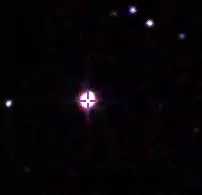PDS 110
PDS 110 is a young 11th magnitude star located approximately 1,090 light-years (335 pc)[2] away in the constellation Orion. In 2017, it was discovered that the star is orbited by an exoplanet or brown dwarf with a disk of dust around it.
 PDS 110 Credit: Two Micron All Sky Survey (2MASS) | |
| Observation data Epoch J2000.0 Equinox J2000.0 | |
|---|---|
| Constellation | Orion |
| Right ascension | 05h 23m 31.008s |
| Declination | –01° 04′ 23.68″ |
| Apparent magnitude (V) | 10.4 |
| Characteristics | |
| Spectral type | keF6IVeb[1][2] |
| Astrometry | |
| Proper motion (μ) | RA: 1.146 ± 1.067[2] mas/yr Dec.: −0.338 ± 1.076[2] mas/yr |
| Parallax (π) | 2.91 ± 0.34[2] mas |
| Distance | 1035[2] ly (335[2] pc) |
| Absolute magnitude (MV) | +2.54[2] |
| Details | |
| Mass | 3.0[3] M☉ |
| Radius | 2.23[2] R☉ |
| Luminosity (bolometric) | 7.76[2] L☉ |
| Surface gravity (log g) | 3.8[2] cgs |
| Temperature | 6,653[3] K |
| Metallicity [Fe/H] | +0.06[2] dex |
| Age | 10[3] Myr |
| Other designations | |
| Database references | |
| SIMBAD | data |
Description
PDS 110 is a young star still approaching the main sequence. It has been classified as a T Tauri star,[4] or as a pre-main sequence star.[3] The emission lines indicative of a T Tauri classification are somewhat weaker than a typical T Tauri star, interpreted as a post-T Tauri stage.[3]
Dust disk around secondary object
| Companion (in order from star) |
Mass | Semimajor axis (AU) |
Orbital period (days) |
Eccentricity | Inclination | Radius |
|---|---|---|---|---|---|---|
| b | 1.8-70 MJ | 2 | 808 ± 2 | — | — | — |
Brightness measurements from SuperWASP and KELT showed two similar reductions in brightness in November 2008 and January 2011, both with a maximal luminosity reduction of 30% and a duration of 25 days. These events were interpreted as transits of a structure with a period of 808 ± 2 days, corresponding to an orbital distance of about 2 AU. The large reduction in brightness could have happened due to a planet or brown dwarf with a circum-secondary disk of dust with a radius of 0.3 AU around a central object with a mass between 1.8 and 70 times the mass of Jupiter. Another transit was predicted for September 2017,[2] but nothing similar to the previous events was seen, ruling out a periodic event.[5]
References
- Miroshnichenko, A. S.; Gray, R. O.; Vieira, S. L. A.; Kuratov, K. S.; Bergner, Yu. K. (1999). "Observations of recently recognized candidate Herbig Ae/Be stars". Astronomy and Astrophysics. 347: 137. Bibcode:1999A&A...347..137M.
- Osborn, H. P.; et al. (2017). "Periodic Eclipses of the Young Star PDS 110 Discovered with WASP and KELT Photometry". Monthly Notices of the Royal Astronomical Society. 471 (1): 740–749. arXiv:1705.10346. Bibcode:2017MNRAS.471..740O. doi:10.1093/mnras/stx1249. S2CID 119450480.
- Rojas, G.; Gregorio-Hetem, J.; Hetem, A. (2008). "Towards the main sequence: Detailed analysis of weak line and post-T Tauri stars". Monthly Notices of the Royal Astronomical Society. 387 (3): 1335. Bibcode:2008MNRAS.387.1335R. doi:10.1111/j.1365-2966.2008.13355.x.
- Gregorio-Hetem, J.; Hetem, A. (2002). "Classification of a selected sample of weak T Tauri stars". Monthly Notices of the Royal Astronomical Society. 336 (1): 197–206. Bibcode:2002MNRAS.336..197G. doi:10.1046/j.1365-8711.2002.05716.x.
- PDS 110 Observing Campaign - Monitoring the potential September 2017 eclipse of young star PDS 110.